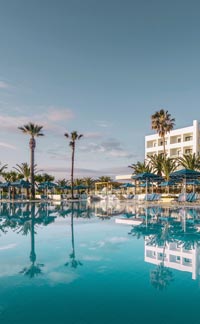Rhodes is the 4th largest in Greece. Rhodes Town is only 10 miles (16 km) from the coast of Turkey. Rhodes has many things to offer- sun-drenched beaches, crystal-clear water, an extensive, multi-cultural history, world-renowned night life, museums, architecture from several different epochs- all of which explains why it is the most popular of the Dodecanese, and one of the most popular tourist destinations in the world.
In mythology, the nymph Rhodes was the daughter of Poseidon (Neptune). Helios, the sun god, fell in love with her and blessed her with his abundant sunshine. Rhodes' first inhabitants were the Telchines, a race with magical powers who were also metalworkers. The first humans to settle there were the Carians, tribe from Phrygia, followed by the Phoenicians. Rhodes became a bronze-age center around 1500 BC, trading with the Minoans, who were next to take over the island.
After the Minoans the Mycenaens came from mainland Greece. About 1100 BC the Dorians came and founded 3 city-states named after the grandchildren of Helios and Rhodes: Lindos (east), Ialyssos (north) and Kameiros (west). Homer mentions them in the Iliad as sending 9 ships to the Trojan war.
From 1000 to 600 BC, the fast ships of Rhodes covered the Aegean, founding colonies such as Naples.
The Colossus, over 100 feet (30 m) tall, and one of the 7 Wonders of the Ancient World, was built in 280 BC, funded by equipment left from a failed siege. In 226 BC it was destroyed by an earthquake.
Rhodes entered into an alliance with Rome in the 2nd century BC. Then it was conquered and plundered by the Roman general Cassius in 42 BC. The Book of Acts in the New Testament mentions St. Paul's visit to Rhodes in the 50's AD. Rhodes became an outpost of the Byzantine Empire in 395 AD. The Arabs came in 653, and then the Genoese in 1046 AD. Rhodes was re-captured by the Byzantines in the 11th century AD.
in 1309 the Maltese Knights of St John came. They used the island as a base for raids on the Muslim-occupied Holy Land.
In 1523 the Ottoman Turks conquered Rhodes. The Greeks were forced to move outside the city walls. Rhodes became two cities; the "Old Town (the fortified city)," and the "New Town." The Italians took Rhodes in 1912, and stayed until 1947, when the islands were transferred to Greece.
Rhodes Old Town
The Old Town is one of the largest, best-preserved medieval cities in Europe. It is a fascinating mix of cultures, civilizations, and architectural traditions, of old fountains, narrow, stone-paved streets bordered by buildings with Gothic arches, charming little cafes on its many compact public squares, Byzantine-era churches, medieval mosques, and huge stone walls and gates. It is a UNESCO World Heritage Site.
Best hotels in Rhodes
A favorite among Rhodes’ 5-star resorts, the Amada Colossos earns annual repeat visits from every corner of the globe.
First-class all-inclusive resort for the whole family on one of the most interesting and popular Aegean islands, Rhodes
Mitsis Faliraki is a charming ultra-all-inclusive 24h 5* beach hotel, close to the cosmopolitan town of Faliraki, on the east coast of Rhodes.
Rhodes New Town
The administrative and commercial center of the Dodecanese, New Town is thoroughly modern. Much of New Town was built during the Italian era. It has older neo-classical buildings next to modern construction, reflecting Rhodes' cosmopolitan character.
The central Kyprou (Cyprus) Square is always busy. The seafront walk is very pleasant, and there are remarkably clean beaches. The Aquarium, featuring sea turtles and other rare Mediterranean species, is the only one of its kind in Greece.
There are dozens of bars, nightclubs, tavernas, and restaurants. The 15th century fort and lighthouse Agios Nikolas is at the end of the harbor mole enclosing Mandraki, which was the ancient harbor. There are 3 windmills on the breakwater. The 3 windmills are the only survivors of a line of 14 medieval windmills used to grind grain
Above the city to the southwest is the old acropolis, containing columns from the Temple of Apollo. At a scenic 150 feet (45 m) above the city, the acropolis was an integral part of Ancient Rhodes. Surrounding the acropolis is beautiful Rodini Park, with magnificent trees, walkways, grottos, and shallow caves.















